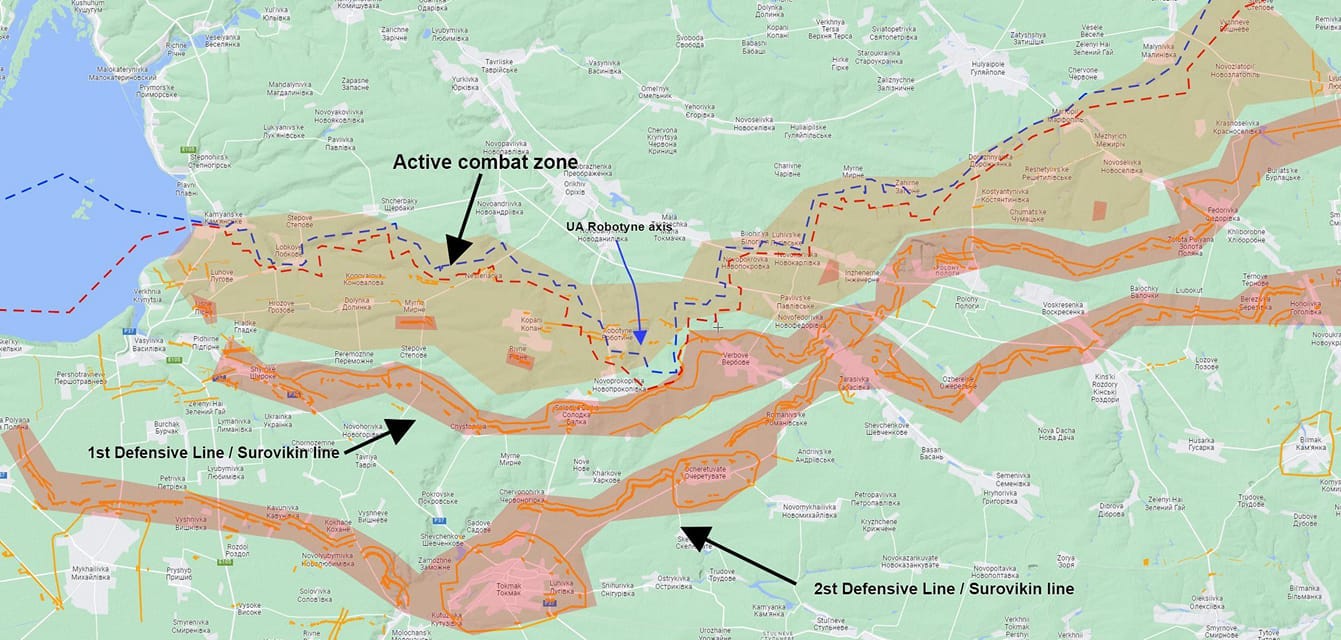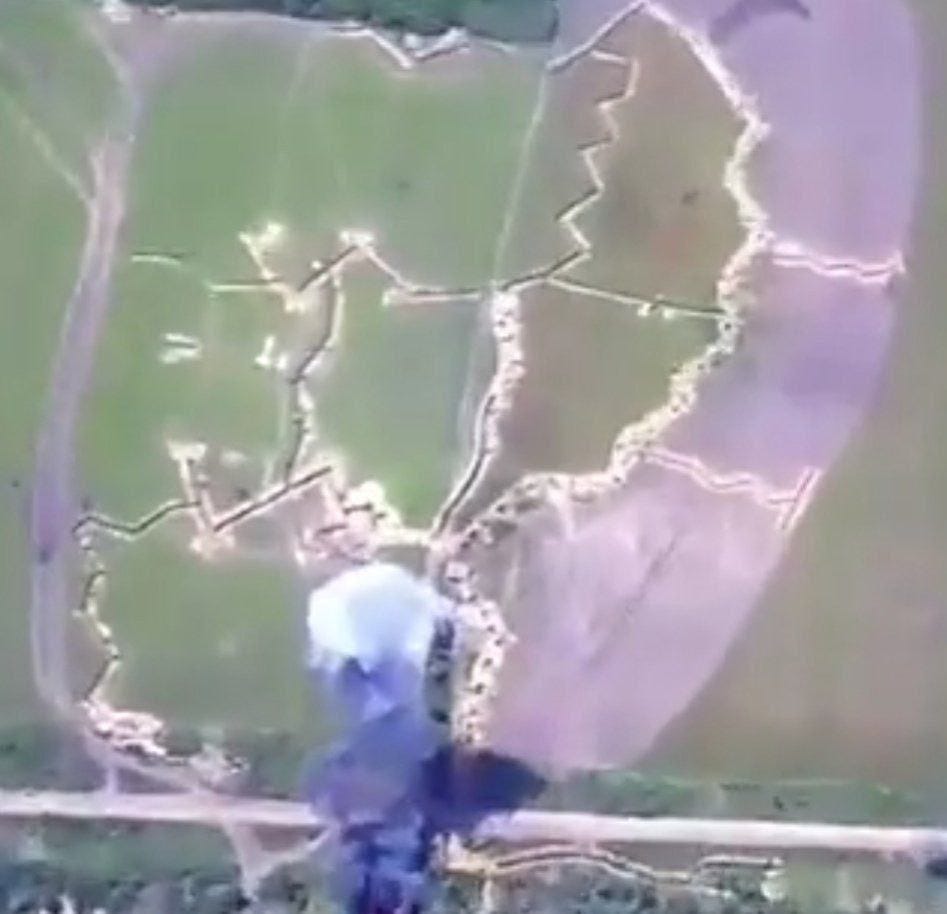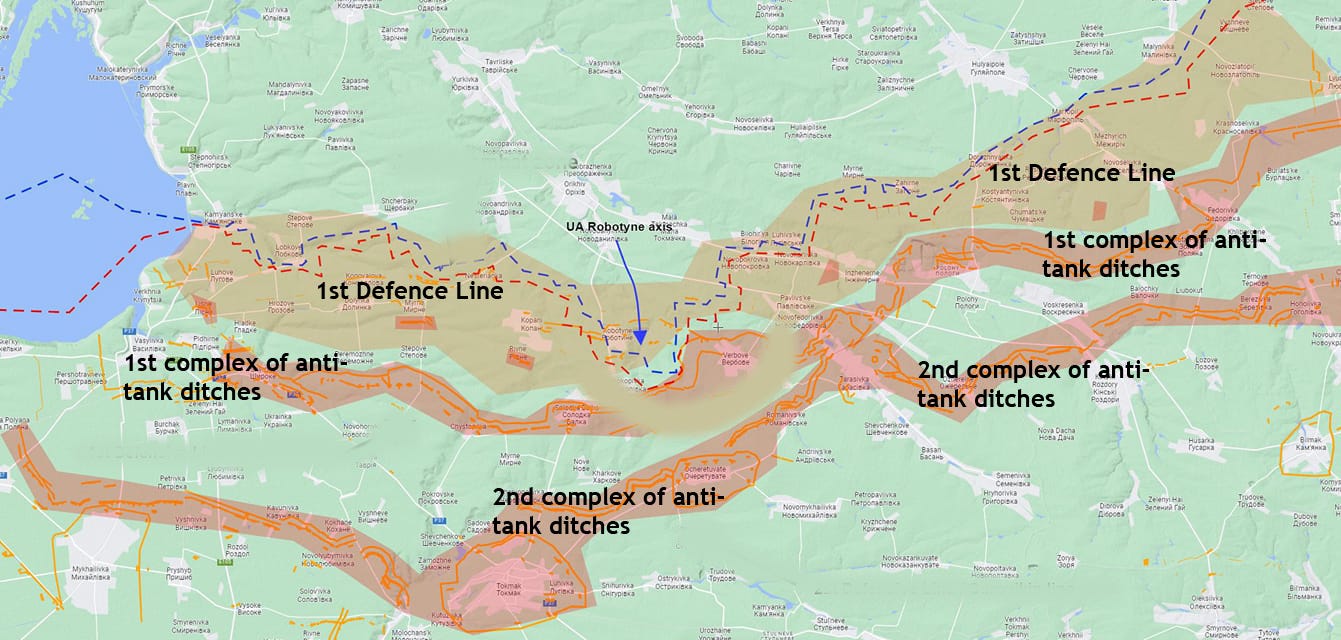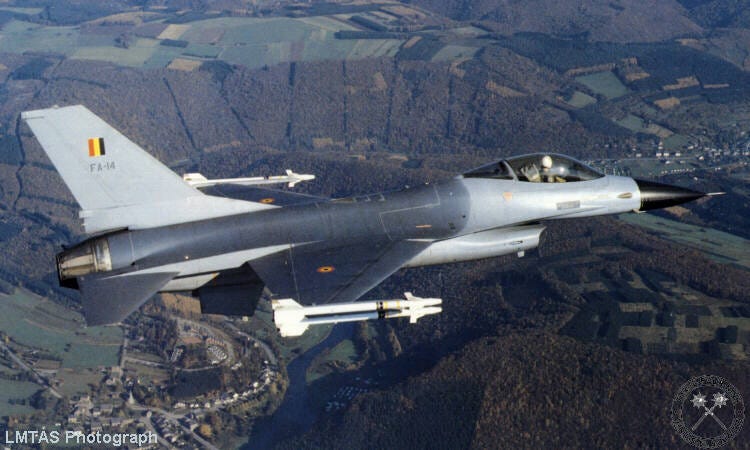Military analyst Tom Cooper answers the main questions about the Russian-Ukrainian war and the counteroffensive of the Armed Forces. What do Russian defense lines mean and why are F16s not as effective as they might seem?
Today, I would like to thank you all for the patience with me - and that in form of addressing few ‘selected’ (or ‘particularly good’) questions asked over the last week ‘or so’, here on the Sarcastosaur.

***
1.) Where is the ZSU offensive in the south heading, i.e. what after Verbove?
Think, the ZSU (i.e. the Group of Forces Tavriya), has already offered an answer. With the Russians stuffing their frontlines south of Robotyne and Staromlynivka full of units…. Ukrainians hit somewhere else. News of the day is that – after several ‘probing/diversionary’ attacks south of Vuhledar, and after two days of massive artillery preparation - Ukrainian units launched major attacks on Novodonetskoye and Novomaiorske, roughly half-way between Staromaiorske and Vuhledar.
Why that?
Because the Russian commanders have significantly depleted their units in this area. They took away a battalion from the 131st MRR, a battalion from the 1466th MRR, at least a battalion from (already dilapidated) 40th NIB, and at least a battalion from their 36th MRB – and have sent these to reinforce depleted units south of Staromaiorske, perhaps even to the 58th CAA in the Robotine-Novoprokopivka-Verbove sector.
One way or the other, they’re, once again, going to face a major crisis and have to rush troops from one sector of the frontline to another, to patch. No surprise, RUMINT from Moscow is that Pudding would like to mobilise another 200,00 by 1 November…
In a battle of attrition of this scope and size, that’s – pending any kind of serious deliveries of heavy weapons from NATO (because, what NATO has delivered so far is ‘kindergarten’ in comparison to what Ukraine needs, or to what NATO could deliver, if its incompetent and corrupt administrators wouldn’t be suffering from too many illusions) – the only solution on hand. Why?
Because, ZSU units attacking in this area are facing a lower number of enemy troops, while the Keystone Cops in Moscow are now facing a dilemma: they know the ZSU still has at least a dozen of fresh brigades. So, is this going to become a new ‘major strike’ or not? And, shall they let their depleted units defending the Novodonetskoye and Novomaiorske stretch of the frontline get destroyed by this Ukrainian attack, or return whatever was left of their ‘reinforcements’ back to this area? Or, re-route those reinforcements underway to Robotyne-Novoprokopivka-Verbove and/or Staromaiorske back to this sector….? And what if Ukrainians then deploy their fresh brigades to continue attacking between Novoprokopivka and Verbove….
***
2.A) What is behind the 2nd Russian Defence Line?
2.B) Indeed, where is the Russian 1st Line, where is the 2nd etc….?
This is a topic of lots of – often fierce – discussions, and I do not agree with the mass of related conclusions. Here’s a classic example:

By all respect for the gent that collected the info and then drew it tidily on this map, this is simply wrong info. Like so many others, he’s talking about ‘active combat zone’, and 1st Line, and ‘2nd Line’, and thus creating the impression like, ‘ah, just cross the line and it’s going to be fine’.
As explained time and again since around mind-June (check my old posts should there be any doubts), this is neither how the Russians have constructed their defence line, nor how they’re fighting, nor how are they all the time constructing additional defence lines.
Essence of the problem is the following: the classic military thinking (and thus indoctrination) is something like:
a) You first lay that nice minefield, then
b) somewhere behind the minefield, you dig a big anti-tank ditch, and then
c) somewhere behind that big anti-tank ditch, you entrench your troops.
By now, after three months of this offensive, it should be clear to everybody: this is NOT the way the Russians are operating nowadays. Go and chat with ZSU officers and other ranks, and they’ll tell you: for the Russians, the ‘active combat zone’ is only relevant in so far that this is a mix of a giant minefield and their 1st Defence Lline. And this 1st Defence Line is not characterised – nor protected – by that big anti-tank ditch. Nope. It consists of dozens and hundreds of smaller positions, shorter trenches, or trench complexes, dug into almost every hedgerow they could find, and surrounded by extensive minefields. Indeed, several of ‘trenches’ in question were outright ‘forts’. Here a still of one south of Robotyne, apparently overrun by the ZSU, today:

Thus, actually, the frontline is the 1st Defence Line – and the Russians do not have any other defence line.
What’s further south are anti-tank ditches and – as far as prepared by now – empty positions waiting for troops to fall back upon them. With other words, the situation is like this:

Correspondingly, what the ZSU has reached so far is not ‘breach of the 2nd Line’, but: the ZSU has ‘crossed minefield and then the 1st and the 2nd anti-tank ditch of the 1st Line/Complex of anti-tank ditches’.
Of course, this is complex to explain, so people are ‘shortening it’ to ‘1st Defence Line’ (to make sure: I’m doing that mistake too, time and again), although this is simply wrong…
Now, don’t worry: considering how little heavy engineering equipment the ZSU has (thank you, NATO) this is a major achievement, but in grand total it doesn’t mean as much as it might appear at first. Here the reasons.
As explained at least one or two times, the ZSU attacked in the Robotyne area and then between Novoprokopivka and Verbove because the Russian minefield was at its narrowest in that area, and – further south – also the two major anti-tank ditches are coming together. Means: cross the minefield, cross two anti-tank ditches, and you’re over them, instead of having to cross 3-4-5 or more. In order to reach these two anti-tank ditches, the ZSU had to cross ‘just’ some 7-10km of minefields, and then fight itself through another 5-7km of Russian trench systems.
….all which is also the answer to the question: and what is behind that 2nd anti-tank ditch?
The answer is simple: it’s the 1st Russian Defence Line.
Sure, this is not sexy to conclude, and doesn’t sound logical. But, that’s the wy the Russians are fighting nowadays. It means that, ‘behind that 2nd anti-tank ditch, there are yet more of well-concealed Russian positions in every hedgerow they could find.
…and a growing number of these positions are ever more sophisticated. Some have top cover, so that they’re not easy to destroy by mortar bombs lighter than 120mm, or by cluster bomblets deployed by artillery shells. They really need a direct hit by 155mm; some even so-called ‘bunker-busters’.
That’s the 1st Russian Defence Line, and that’s going to remain the 1st Russian Defence Line, even once the ZSU overcomes it and gets to Tokmak and beyond, sometimes in the future. The reason is that, due to the failure of the West to re-arm Ukraine, the ZSU has not enough heavy equipment for a mechanised advance. Which means that Ukrainian infantry can only advance at the infantry pace, which is the same pace at which the Russians are withdrawing, which in turn means that every time Ukrainians break through the 1st Line of Defence, the Russians have enough time to bring in another reserve unit from somewhere, and construct/patch up the 1st Line of Defence, somewhere further to the rear.
…while all these ‘big Russian defence lines’ further south are still what they used to be: anti-tank ditches. ‘Something attractive to watch on satellite photos’, and thus useful as a distraction from reality.
Bottom line, by all the immense efforts and incredible courage of Ukrainian troops: sorry, actually, we’re still at the ‘Point 1’. Which is: Ukraine hasn’t got enough tanks, infantry fighting vehicles, engineering equipment nor ammunition to run this offensive in form of rapid mechanised assaults. It hasn’t even got enough air defence systems to protect both the major municipalities in the rear, and industrial/exporting facilities, and the frontline…
And, sorry but: there is no change in this regards in sight – as nicely summarised here. On the contrary: after the experience of the last autumn, and all the delays of the last winter, we now must hope the idiots in Washington, Brussels, Berlin, London, Paris and few other places aren’t going to do exactly the same mistake they did the last autumn – and, de-facto, stop supplying enough shells for Ukrainian artillery, and then start supplying next batches of heavy weapons only in spring the next year…. (oh dear….)
(…and, please, don’t go now explaining me I’m ‘so pessimistic today’ and similar nonsense: as always, I’m realistic. At most ‘warning’, people not to flip out in delirium over the ZSU overcoming….essentially, two anti-tank ditches.)
***
3.) All of which is bringing me to the question/commentary No. 3, asked….gulp! ….think it was some 3-4 weeks ago, meanwhile….can’t even find it any more….but, from memory, it was something like this: ‘have I changed my mind on F-16s for Ukraine’?
Cost-wise, total-effectiveness (in terms of kilogram/pound delivered on enemy, per buck spent to do so): nope.
Unless lots of physical- and a few laws of economy experience some kind of fundamental changes (not to say ‘violations’): there is no reason for me to ‘change my conclusions’. This is so because 1+1= 2. No matter where, when, or how (yes: even in Russia under Pudding). And upside down, too. Facts do not change – or if, thanks to inflation in the West of this year, then the prices only got higher.
Means: F-16s – all provided the involved characters get their stuff together and we experience any deliveries of them in our life-times – are, foremost, going to increase the costs of this war for Ukraine.
That much about that aspect. Now lets try to discuss tactics (so far, I’ve been ‘just discussing logistics’ of this topic), because there’s a bunch of related issues to talk about…
The F-16s Ukraine is likely to get as first are designated F-16AMs. These are overhauled and modernised aircraft originally delivered to Belgian, Danish, and similar air forces sometimes back between 1979 and 1991. Indeed, can recall their deliveries because I was a little boy back then, and at the time (late 1970s), it was the McDonnell-Douglas F-4 that was the ‘super fighter of the day’. And then a new generation of latest fighter jets came in: F-14, and F-15, and yes, F-16. And all were hyped, but none as much as the F-16. See: ‘electric jet’ and ‘can do it all’ and whatever else. Here even a photo of one of first F-16As delivered to Belgium back in 1979 (mind: this was Block 1 aircraft: current production standard is somewhere at F-16V Block 70/72 or something of that kind….)

Means: these F-16s are some 30 to 40 years old, flown ‘almost to death’. So much so, just today the Belgians reported their F-16s have all been grounded and can’t be delivered because they’re in much too poor condition, and because of engine-related problems (which, in the case of ‘best engines of the world’ – see: those made by Pratt & Whitney – is no surprise at all: these have already caused crashes of dozens of F-16s…). Don’t worry: exactly the same is valid for Danish and Dutch F-16AMs. With other words: actually, they’re in no better condition than MiG-29s, Su-24s, Su-25s and Su-27s currently flown by the PSU.

But OK, let’s say they’re going to find and solve the problem, and deliver them, and the PSU presses them in combat (actually, I have no idea what problem do they want to find and solve: imagine trying to drive a 40 years old Fiat. It’s not going to become a new Fiat, no matter what one does… except, of course, one buys a new car….).
Anyway…
Primary air-to-air weapon of the F-16AM is the AIM-120C. This has an effective engagement envelope of around 50, perhaps 60km – all provided the jet is flying high and fast. The higher and faster the jet flies at the time it’s releasing the missile, the further the missile can reach. Sure, the manufacturer is claiming more, but I’m talking about what was proven in combat so far: when Pakistanis started shooting AIM-120Cs from 60+ km distance at Indian Su-30MKIs, few years ago (and that, yes, from high altitude and high speed), so many of these have missed, there was an impression of Pakistani AIM-120Cs migrating to India…
Just for comparison: the principal air-to-air weapon of Russian MiG-31s and Su-35s is the R-37M missile. This has a maximum engagement envelope of well over 120, probably up to 200km (again: yes, I know, some are claiming ‘400km’, but I wonder how do they want to find a target for that weapon over such a range). And, after a few nasty experiences with Ukrainian MiG-29s from early during their invasion, the Russians simply do not care any more: they’re firing their R-37Ms from as far as they can. They’re not trying to shorten the range or enter the optimum engagement envelope, but they’re: ‘shooting first, asking questions later’. From their point, no problem, because the Keystone Cops are declaring every R-37M fired = aerial victory against an Ukrainian aircraft/helicopter, and pilots are getting medals and money. So, why care if the missile is wasted? Besides, nobody said it’s ‘automatically wasted’: see the loss of two Ukrainian helicopters, few days ago, caused by a Russian Su-35S engaging them with R-37M. It’s even unclear if the missile/s actually hit; but the helos crashed, killing both crews….
Means: F-16s are going to have it awfully hard just to try combating any of Russian aircraft. Which in turn means that, just like currently-available MiG-29s and Su-27s, they’re going to end trying to catch Shahed-136s LPGMs and similar Russian weapons, instead of trying to fight Russian aircraft.
Well, at least their radar has better performances for such tasks, than the old stuff on Ukrainian MiG-29s and Su-27s…
When it comes to air-to-ground, the picture is even bleaker. F-16AMs are not compatible with Storm Shadow and/or SCALP-EG. Means, they’re going to need another new weapon to fly strikes like Su-24Ms are already doing. Say: AGM-145 JASSM. That’s something like US-equivalent to the Storm Shadow. Means: not only will Washington - which is already now doing everything in its powers to delay the F-16-deliveries - have to grant permission for export of another sophisticated US weapon to Ukraine, but PSU pilots will have to learn to operate yet another new weapon…
As next: F-16 was originally designed as a lightweight air superiority fighter, armed with short-range air-to-air missiles (AIM-9 Sidewinders) and M61 Vulcan gun (20mm). They were designed for dogfighting such aircraft like Soviet MiG-17s and MiG-21s. Correspondingly, F-16 has got a wing suitable for turning combat at high-subsonic speeds: that’s where it can outmanoeuvre/outturn almost any other combat jet on this planet.
However, for deployment of missiles like Storm Shadow/SCALP-EG/JASSM, the jet needs speed. And the F-16 was not designed for high-speed operations – especially not for such operations at low altitude. Su-24M was. Which is why Su-24M is faster than F-16 when flying low. Moreover, Su-24M was optimised for such operations: it’s got a variable-sweep wing. Inner part of that wing is retracting into the fuselage as it’s swept to the rear. That’s decreasing the wing surface, which is great because of something called ‘gust response’. Essentially, that’s vibrations suffered by aircraft because of the turbulent air at low altitude. See: after flying F-16 at, say, 1,200km/h at 100m altitude for some 10-16 minutes,, the pilot’s brain is rattled to the point where he/she can’t think reasonably any more. On the contrary, Su-24M is ‘comfortable’ in that flight regime, gust response is no problem for it.
Finally, Su-24M can outaccelerate F-16 at low altitude – which is highly important, then the less time any such jet is spending with approaching to within the range of its Storm Shadow/SCALP-EG/JASSM, the less time the Russian MiG-31s and/or Su-35s have to intercept it… and the faster the jet flies while releasing such weapons, the further the missiles can reach.
With other words: F-16 is ‘looking cool’ and ‘US made’ and has few good weapons and some cool avionics, and is certainly good for few other things, and I can understand Ukrainian pilots are going to be happy to fly it…. However, it’s a sort of ‘jack of all the trades, master of dogfighting only’. It’s not made to fight this war in Ukraine of the Years 2022/2023/2024….
….and there are plenty of (good) reasons why they were designing jets like Su-24, back in the 1960s and 1970s.
…and that’s still not answering the question: what idiot is expecting that one worn out, 40-years-old jet, can replace another type of worn-out, 40-years-old jet – and that in a war the end of which is nowhere in sight?
This text is published with the author's consent. First published here